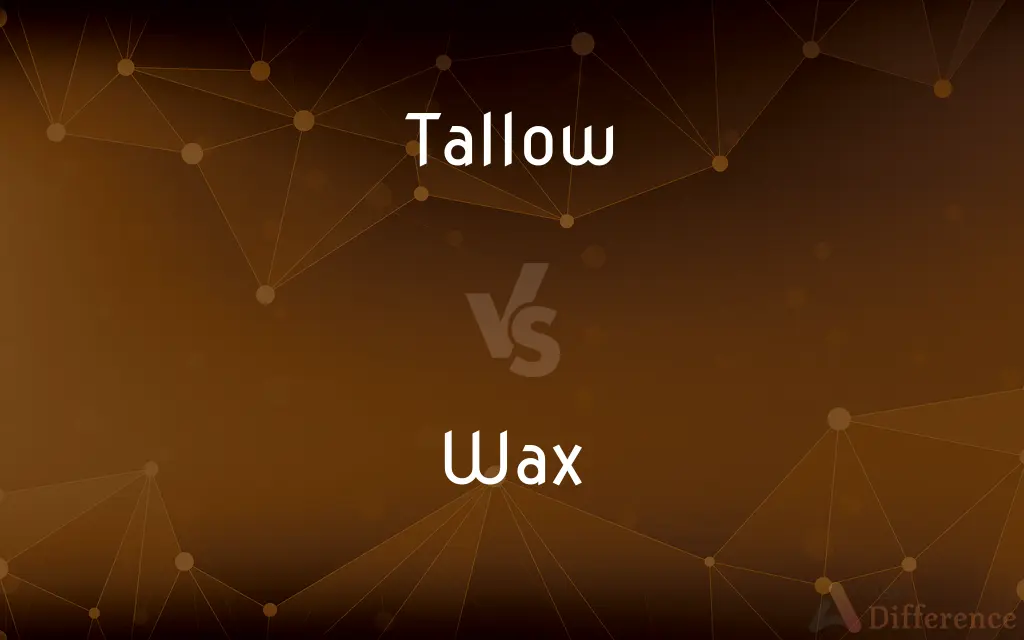Tallow vs. Wax — What's the Difference?
By Fiza Rafique & Maham Liaqat — Updated on April 1, 2024
Tallow is rendered animal fat used in candles and soaps, while wax is a broad category of substances, including plant, animal, or synthetic origins, used for making candles, seals, and polishes.

Difference Between Tallow and Wax
Table of Contents
ADVERTISEMENT
Key Differences
Tallow, traditionally sourced from beef or mutton fat, has been a staple in the production of candles and soap for centuries. Its primary use is in industries where the solidity and fatty properties of animal fat can be advantageous, such as in the making of traditional candles and soaps. On the other hand, wax encompasses a wider range of materials, including beeswax (animal-derived), paraffin (petroleum-based), soy wax (plant-based), and others, each with distinct properties and uses ranging from candle making to cosmetics, food coating, and beyond.
The production of tallow involves rendering, which is the process of melting down animal fats to separate impurities from the fat, resulting in a solid product at room temperature. This method has been practiced for millennia, with tallow candles once being a primary source of light. Whereas wax production varies significantly depending on the source material—beeswax is harvested from bee hives, paraffin is a byproduct of petroleum refining, and vegetable waxes like soy are extracted and processed from plants.
In terms of environmental impact and sustainability, tallow's use raises concerns related to animal farming and its associated impacts. While it is often praised for being a byproduct of the meat industry, thereby utilizing otherwise discarded materials, its sustainability is tied to the larger environmental footprint of animal agriculture. Conversely, the sustainability of wax depends on its source; plant-based waxes are considered more sustainable and eco-friendly, whereas paraffin wax raises concerns due to its petroleum origin, and beeswax production is dependent on the health and sustainability of bee populations.
Aesthetically and functionally, tallow and the various types of wax offer different qualities. Tallow candles have a distinct smell and burn quality, which may not be as clean or as long-lasting as those made from certain waxes, such as paraffin or soy wax. Waxes can also vary widely in their properties—beeswax emits a natural honey-like fragrance when burned, soy wax is known for its clean burn and ability to hold fragrance, and paraffin offers a high melting point and thus a longer burn time.
The choice between tallow and wax often comes down to the intended use and personal or industrial preferences. Tallow may be favored for its traditional qualities and role in soap making, while waxes offer versatility, with options suitable for everything from luxury scented candles to waterproofing, illustrating the diversity of uses beyond traditional candle making.
ADVERTISEMENT
Comparison Chart
Source
Rendered animal fat, typically beef or mutton.
Various, including beeswax, paraffin, and soy wax.
Primary Uses
Candles and soap.
Candles, cosmetics, sealants, and polishes.
Production Process
Rendering to separate fat from impurities.
Varies: extracted from plants, refined from petroleum, or harvested from bees.
Environmental Impact
Linked to animal farming; utilizes byproducts.
Varies: plant-based waxes are more sustainable, whereas paraffin is derived from petroleum.
Properties
Solid at room temperature, distinct smell when burned.
Varies widely: can be fragrant (beeswax), offer a clean burn (soy), or have a high melting point (paraffin).
Compare with Definitions
Tallow
Byproduct of the meat industry, with concerns about sustainability.
Utilizing tallow in products can be seen as making full use of animal resources.
Wax
A diverse category of substances with a variety of sources and uses, including candle making.
Beeswax candles are prized for their natural fragrance and clean burning properties.
Tallow
Has a distinctive smell when burned and is solid at room temperature.
Tallow-based products may carry a unique scent characteristic of animal fats.
Wax
Offers options for different burn qualities and melting points.
Paraffin wax is often used in candles for its long burn time and stability.
Tallow
Provides a slow burn, historically valued for lighting.
Tallow was valued for its availability and utility in candle making.
Wax
Properties such as fragrance, burn time, and melting point vary widely.
Choosing the right type of wax can enhance the candle-making process and product quality.
Tallow
Rendered fat from animals, primarily used in making candles and soap.
Tallow candles were once a common light source before the advent of electricity.
Wax
Can be derived from animals (beeswax), plants (soy wax), or petroleum (paraffin).
Soy wax is popular in candle making for its environmental benefits and performance.
Tallow
Derived from the fat of cattle or sheep.
Traditional soap making often involves the process of rendering tallow.
Wax
Sustainability varies by type; plant-based waxes are more eco-friendly.
The choice of wax can impact the environmental footprint of candle production.
Tallow
Tallow is a rendered form of beef or mutton fat, primarily made up of triglycerides. It is solid at room temperature.
Wax
Waxes are a diverse class of organic compounds that are lipophilic, malleable solids near ambient temperatures. They include higher alkanes and lipids, typically with melting points above about 40 °C (104 °F), melting to give low viscosity liquids.
Tallow
Hard fat obtained from parts of the bodies of cattle or sheep, used in foodstuffs or to make leather dressing, soap, and lubricants, and formerly used to make candles.
Wax
A sticky yellowish mouldable substance secreted by honeybees as the material of a honeycomb; beeswax.
Tallow
Any of various similar fats, such as those obtained from plants.
Wax
Used in reference to records
He didn't get on wax until 1959
Tallow
To smear or cover with tallow.
Wax
A fit of anger
She is in a wax about the delay to the wedding
Tallow
To fatten (animals) in order to obtain tallow.
Wax
Cover or treat (something) with wax or a similar substance, typically to polish or protect it
I washed and waxed the floor
Tallow
A hard animal fat obtained from suet, etc.; used in cooking as well as to make candles, soap and lubricants.
Wax
Make a recording of
He waxed a series of tracks that emphasized his lead guitar work
Tallow
To grease or smear with tallow.
Wax
(of the moon between new and full) have a progressively larger part of its visible surface illuminated, increasing its apparent size.
Tallow
To cause to have a large quantity of tallow; to fatten.
To tallow sheep
Wax
Begin to speak or write about something in the specified manner
They waxed lyrical about the old days
Tallow
The suet or fat of animals of the sheep and ox kinds, separated from membranous and fibrous matter by melting.
Wax
Any of various natural, oily or greasy heat-sensitive substances, consisting of hydrocarbons or esters of fatty acids that are insoluble in water but soluble in nonpolar organic solvents.
Tallow
The fat of some other animals, or the fat obtained from certain plants, or from other sources, resembling the fat of animals of the sheep and ox kinds.
Wax
Beeswax.
Tallow
To grease or smear with tallow.
Wax
Earwax.
Tallow
To cause to have a large quantity of tallow; to fatten; as, tallow sheep.
Wax
A solid plastic or pliable liquid substance, such as ozocerite or paraffin, originating from petroleum and found in rock layers and used in paper coating, as insulation, in crayons, and often in medicinal preparations.
Tallow
Obtained from suet and used in making soap, candles and lubricants
Wax
A preparation containing wax used for polishing floors and other surfaces.
Wax
A resinous mixture used by shoemakers to rub on thread.
Wax
A cosmetic procedure in which facial or body hair is removed by peeling away a layer of wax that has been allowed to harden.
Wax
A fit of anger
"All at once you would suddenly find yourself reverting to childish attitudes, flaring up in a wax with some fellow" (Frank O'Connor).
Wax
Made of wax
A wax candle.
Wax
To coat, treat, or polish with wax.
Wax
To remove (facial or body hair) by covering the skin with a layer of wax that is peeled off after hardening, uprooting the encased hairs.
Wax
To remove hair from (a portion of the body) by this method.
Wax
To increase gradually in size, number, strength, or intensity
“His love affair with Mrs. Bernstein waxed and waned and waxed again” (C. Hugh Holman).
Wax
To show a progressively larger illuminated area, as the moon does in passing from new to full.
Wax
To grow or become as specified
“His very body had waxed old in lowly service of the Lord” (James Joyce).
Wax
To speak or write as specified
“[He] warmed to his most favorite of subjects, waxed eloquent, gained in his face a glow of passion” (Paul J. Willis).
Wax
Beeswax.
Wax
Earwax.
What role does the wax in your earhole fulfill?
Wax
Any oily, water-resistant, solid or semisolid substance; normally long-chain hydrocarbons, alcohols or esters.
Wax
Any preparation containing wax, used as a polish.
Wax
The phonograph record format for music.
Wax
A thick syrup made by boiling down the sap of the sugar maple and then cooling it.
Wax
A type of drugs with as main ingredients weed oil and butane; hash oil.
Wax
(rare) The process of growing.
Wax
An outburst of anger, a loss of temper, a fit of rage.
Wax
Made of wax.
Wax
(transitive) To apply wax to (something, such as a shoe, a floor, a car, or an apple), usually to make it shiny.
Wax
(transitive) To remove hair at the roots from (a part of the body) by coating the skin with a film of wax that is then pulled away sharply.
Wax
To defeat utterly.
Wax
To record.
Wax
To increasingly assume the specified characteristic.
To wax eloquent
Wax
To grow.
Wax
To appear larger each night as a progression from a new moon to a full moon.
Wax
To move from low tide to high tide.
Wax
To increase in size; to grow bigger; to become larger or fuller; - opposed to wane.
The waxing and the waning of the moon.
Truth's treasures . . . never shall wax ne wane.
Wax
To pass from one state to another; to become; to grow; as, to wax strong; to wax warmer or colder; to wax feeble; to wax old; to wax worse and worse.
Your clothes are not waxen old upon you.
Where young Adonis oft reposes,Waxing well of his deep wound.
Wax
To smear or rub with wax; to treat with wax; as, to wax a thread or a table.
Wax
A fatty, solid substance, produced by bees, and employed by them in the construction of their comb; - usually called beeswax. It is first excreted, from a row of pouches along their sides, in the form of scales, which, being masticated and mixed with saliva, become whitened and tenacious. Its natural color is pale or dull yellow.
Wax
Hence, any substance resembling beeswax in consistency or appearance.
Wax
Cerumen, or earwax.
Wax
A waxlike composition used for uniting surfaces, for excluding air, and for other purposes; as, sealing wax, grafting wax, etching wax, etc.
Wax
A waxlike composition used by shoemakers for rubbing their thread.
Wax
A substance similar to beeswax, secreted by several species of scale insects, as the Chinese wax. See Wax insect, below.
Wax
A waxlike product secreted by certain plants. See Vegetable wax, under Vegetable.
Wax
A substance, somewhat resembling wax, found in connection with certain deposits of rock salt and coal; - called also mineral wax, and ozocerite.
Wax
Thick sirup made by boiling down the sap of the sugar maple, and then cooling.
Wax
Any of numerous substances or mixtures composed predominantly of the longer-chain saturated hydrocarbons such as the paraffins, which are solid at room teperature, or their alcohol, carboxylic acid, or ester derivatives.
Wax
Any of various substances of either mineral origin or plant or animal origin; they are solid at normal temperatures and insoluble in water
Wax
Cover with wax;
Wax the car
Wax
Go up or advance;
Sales were climbing after prices were lowered
Wax
Increase in phase;
The moon is waxing
Common Curiosities
Can tallow and wax be used interchangeably in making candles?
While both can be used to make candles, they offer different qualities such as burn time and scent, making them not directly interchangeable without considering these factors.
Which is more sustainable, tallow or plant-based wax?
Plant-based waxes, like soy wax, are generally considered more sustainable due to their renewable sources and lower environmental impact compared to tallow.
Do tallow candles have a distinct smell?
Yes, tallow candles can have a distinct smell due to their animal fat content, which may not be as neutral as some waxes like soy or paraffin.
Is beeswax considered a more eco-friendly option than paraffin wax?
Yes, beeswax is often considered more eco-friendly than paraffin wax because it is a natural, renewable resource, unlike paraffin, which is derived from petroleum.
Are there any candles that don't emit a scent when burned?
Candles made from certain types of wax, like refined paraffin or some soy waxes, can burn with little to no scent, depending on the addition of fragrances.
What are the benefits of using beeswax in candles?
Beeswax candles burn cleanly, emit a natural honey-like fragrance, and purify the air by releasing negative ions.
What is the main difference between tallow and wax?
The main difference is their source: tallow is animal fat, while wax can come from various sources, including animals, plants, or petroleum.
How does the environmental impact of wax compare to tallow?
The environmental impact varies: tallow is a byproduct of the meat industry, while waxes like paraffin have a petroleum base. Plant-based waxes are generally more environmentally friendly.
What makes soy wax popular in candle making?
Soy wax is popular for its renewable source, clean burn, and ability to hold fragrance, making it a preferred choice for scented candles.
Can the choice of candle wax affect burn time?
Yes, the type of wax can significantly affect a candle's burn time. For example, paraffin wax typically allows for a longer burn time compared to other types.
Share Your Discovery

Previous Comparison
Returnee vs. Regressor
Next Comparison
Growth vs. ProgressAuthor Spotlight
Written by
Fiza RafiqueFiza Rafique is a skilled content writer at AskDifference.com, where she meticulously refines and enhances written pieces. Drawing from her vast editorial expertise, Fiza ensures clarity, accuracy, and precision in every article. Passionate about language, she continually seeks to elevate the quality of content for readers worldwide.
Co-written by
Maham Liaqat













































